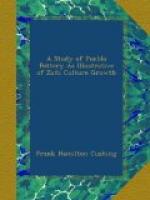In quality of art quite as much as in that of material this local influence was great. In the neighborhood of ruined pueblos which occur near mineral deposits furnishing a great variety of pigment-material, the decoration of the ceramic remains is so surprisingly and universally elaborate, beautiful, and varied as to lead the observer to regard the people who dwelt there as different from the people who had inhabited towns about the sites of which the sherds show not only meager skill and less profuse decorative variety, but almost typical dissimilarity. Yet tradition and analogy, even history in rare instances, may declare that the inhabitants of both sections were of common derivation, if not closely related and contemporaneous. Probably, at no one point in the Southwest was ceramic decoration carried to a higher degree of development than at A’ wat u i, yet the Oraibes, by descent the modern representatives of the A’ wat u i ans are the poorest potters and painters among the Mokis. Near their pueblo the clay and other mineral deposits mentioned as abundant at A’ wat u i are meager and inaccessible. Still, it may be urged that time may have introduced other than natural causes for change; this could not be said of another example pertaining to one period and a single tribe. I refer again to the Zunis. The manufactures of Pescado probably surpass in decorative excellence all other modern Pueblo pottery, while both in their lack of variety and in delicacy of execution of their painted patterns the fictiles of Ojo Caliente are so inferior and diverse from the other Zuni work that the future archaeologist will have need to beware, or (judging alone from the ceramic remains which he finds at the two pueblos) he will attribute them at least to distinct periods, perhaps to diverse peoples.
POTTERY INFLUENCED BY MATERIALS AND METHODS USED IN BURNING.
Other influences, to a less extent local, had no inconsiderable effect on primitive Pueblo pottery: materials employed and methods resorted to in burning.
Only one kind of fuel, except for a single class of vessels, is now used in pottery-firing; namely, dried cakes or slabs of sheep-dung. Anciently, several varieties, such as extremely dry sage-brush or grease-wood, pinon and other resinous woods, dung of herbivora when obtainable, charcoal, and also bituminous or cannel-coal were employed. The principal agent seems, however, to have been dead-wood or spunk, pulverized and moistened with some adhesive mixture so that flat cakes could be formed of it. I infer this not alone from Zuni tradition, which is not ample, but from the fact that the sheep-dung now used is called, in the condition of fuel, ku ne a, while its name in the abstract or as sheep-dung simply is ma he. Dry-rot wood or spunk is known as ku me. In the shape of flat cakes it would be termed ku mo we or ku me a, whence I doubt not the modern word ku ne a is derived.




